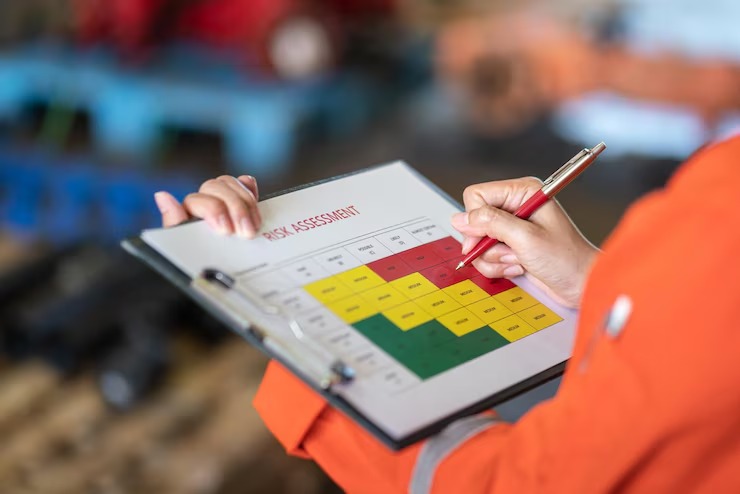In any work environment, employee safety should be a top priority. Yet, workplace accidents still occur far too often – many of them preventable. One of the most effective ways to reduce such incidents is through thorough Hazard Identification and Risk Assessment (HIRA). But this raises a critical question: who is responsible for conducting a hazard assessment?
Understanding who plays a role in identifying hazards – and why their involvement matters – is essential for building a strong safety culture. This article explores the importance of hazard identification, key participants in the process, and how organizations can make risk assessments more effective.
What Is Hazard Identification and Risk Assessment?
Risk Assessment, on the other hand, involves evaluating the likelihood and severity of these hazards and determining the controls needed to mitigate them.
Together, Hazard Identification and Risk Assessment (HIRA) form the foundation of proactive occupational health and safety management.
Why Is Hazard Identification Crucial?
Ignoring hazards can lead to serious consequences, including:
- Employee injuries or fatalities
- Equipment damage and production delays
- Legal liability and regulatory penalties
- Decreased employee morale and trust
Regular hazard assessments help organizations:
- Stay compliant with occupational health and safety regulations
- Reduce the number and severity of incidents
- Encourage a culture of safety and accountability
- Protect both people and property
Without systematic hazard identification, risks can go unnoticed until it’s too late.
Who Is Responsible for Conducting a Hazard Assessment?
The question of who is responsible for conducting a hazard assessment is not always easy to answer – because the process should involve multiple roles within an organization.
1. Supervisors and Line Managers
Supervisors are typically the first in line when it comes to hazard assessments. They oversee daily operations and are most familiar with tasks and processes. Their responsibilities include:
- Identifying unsafe conditions or behaviors
- Ensuring that controls are implemented and effective
- Reporting newly identified hazards
They serve as a crucial link between management and frontline workers.
2. Health and Safety Officers (HSOs)
Dedicated safety personnel or HSOs are trained to lead formal assessments. Their role is to:
- Perform risk evaluations using standardized methods
- Conduct workplace inspections and safety audits
- Train employees on hazard awareness
- Keep up with compliance regulations
They often drive the implementation of comprehensive HIRA processes.
3. Frontline Workers and Employees
Workers are often the first to spot real-time hazards in their environments. Encouraging their involvement is key because:
- They interact with tools, machinery, and materials daily
- They can report near-misses or unsafe conditions quickly
- They may offer practical insights for effective control measures
An engaged workforce strengthens the entire safety ecosystem.
4. Senior Management
While executives may not be on the ground identifying hazards directly, their leadership sets the tone for safety. Their responsibilities include:
- Providing resources for hazard management
- Enforcing policies and supporting safety programs
- Ensuring accountability across departments
Without top-level buy-in, safety programs are unlikely to succeed.
5. External Auditors or Consultants
In certain cases – especially in complex, high-risk industries – organizations may involve third-party professionals to assess hazards. This helps:
- Bring in unbiased, expert evaluations
- Uncover blind spots that internal teams might miss
- Align practices with industry standards
External audits are often used in preparation for certifications or regulatory compliance.
Why Involvement from Multiple Stakeholders Matters in Hazard Assessments
Effective hazard assessments demand collaboration. When only one team handles the responsibility, blind spots emerge, and key risks may be missed. Involving a wide range of stakeholders not only improves accuracy but also makes safety strategies more practical and widely accepted.
Here’s why diverse stakeholder involvement is critical:
- Improved Accuracy and Comprehensiveness
Different roles observe different risks. A machine operator notices hazards that an office-based safety officer might not. Involving shop floor workers, maintenance teams, supervisors, and engineers ensures that all potential risks are captured. - Multiple Perspectives Lead to Smarter Solutions
Each group brings its own expertise. For instance:
- Workers identify real-time safety risks and workflow inefficiencies.
- Supervisors understand procedural gaps and workforce behavior.
- Engineers recognize design flaws and technical limitations.
- Managers ensure alignment with business goals and compliance.
- Workers identify real-time safety risks and workflow inefficiencies.
- More Practical and Sustainable Controls
Solutions developed collaboratively are more likely to be workable. A control designed with operator input is often easier to implement and maintain. - Stronger Ownership and Engagement
When people are involved in the process, they’re more likely to follow through. This builds a proactive culture where safety is seen as a shared goal – not just a policy from the top. - Culture of Accountability and Shared Responsibility
Inclusion sends a message: everyone has a voice in safety. This reinforces a culture where safety is not just a task but a collective value.
Involving stakeholders across all levels – from the C-suite to the floor – leads to more resilient, safer workplaces.
When Should Hazard Assessments Be Conducted?
Hazard assessments shouldn’t be one-time activities. They should occur:
- Before new work begins: Especially when introducing new equipment or procedures.
- After incidents or near misses: To identify root causes and prevent recurrence.
- Periodically as part of routine audits: To ensure existing controls remain effective.
- When changes are made to the workplace: Including layout changes, staffing, or materials.
A proactive and continuous approach reduces the likelihood of surprises.
Steps for an Effective Hazard Identification and Risk Assessment Process
While each organization may follow slightly different procedures, the general steps include:
Step 1: Identify Hazards
- Observe workplace activities
- Inspect equipment and environments
- Review past incidents and near misses
Step 2: Assess the Risks
- Determine the likelihood of occurrence
- Evaluate the severity of consequences
- Prioritize the risks using a risk matrix
Step 3: Implement Controls
- Apply the hierarchy of controls: Elimination, Substitution, Engineering, Administrative, PPE
- Assign responsibilities for implementing each control
- Ensure proper training and documentation
Step 4: Monitor and Review
- Conduct regular audits
- Review the effectiveness of controls
- Adjust strategies as needed
Common Mistakes to Avoid During Hazard Assessments
Even well-intentioned efforts can go wrong. Watch out for these pitfalls:
- Overlooking routine tasks because they seem harmless
- Failing to engage employees in the assessment process
- Skipping documentation which is essential for tracking and accountability
- Assuming previous controls are still effective without re-evaluation
- Not updating assessments after changes in operations or regulations
Avoiding these mistakes ensures your HIRA efforts are both meaningful and compliant.
Encouraging a Culture of Safety and Participation
A strong hazard assessment process depends not just on policies, but on people. Here are a few ways to build that culture:
- Conduct regular safety training across all levels
- Reward hazard reporting to remove fear of blame
- Hold regular toolbox talks focused on real hazards
- Encourage leadership involvement in inspections and walkarounds
When employees see that their input matters, they’re more likely to engage.
Final Thoughts
So, who is responsible for conducting a hazard assessment? The answer is everyone – from workers to senior executives. By involving multiple stakeholders, organizations not only identify hazards more effectively but also build a safer, more engaged workforce.
Investing in Hazard Identification and Risk Assessment isn’t just a regulatory requirement – it’s a business imperative. It protects lives, assets, and reputations.



